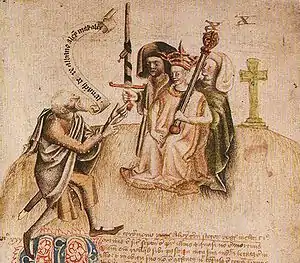Ollam
An ollam or ollamh (anglicised as ollave or ollav), in early Irish literature, is a member of the highest rank of filí. The term is used to refer to the highest member of any group; thus an ollam brithem would be the highest rank of judge, and an ollam rí the highest rank of king. Ollav was also applied to a druidic rank; meaning much the same as "professor", or person of great learning.[1] Typically the ollav/ollam was endowed with a distinction equal to that of a king, and could therefore wear six colours.

There was an official post in ancient Ireland called the "Rí Ollam" or "Ard Ollam" or Chief Ollam of Ireland. The holder of the post had a standing equal to the High King of Ireland. One of the most famous Ollav/Ollam of Ireland was Ollav Fala, eighteenth descendant of Érimón, in around 1000 BC.[2]
Ollamh Fodhla, meaning "great teacher", was used to designate various prominent men throughout history.
Literary fosterage
In Ancient Ireland, ollams taught children either for payment or for no compensation.[3]
See also
References
- "Sacred text archives". Internet Sacred Text Archives. Retrieved 2013-09-28.
- "Sacred text archives". Internet Sacred Text Archives. Retrieved 2013-09-28.
- "Fosterage in Ancient Ireland". Library Ireland. Retrieved 2012-06-16.
